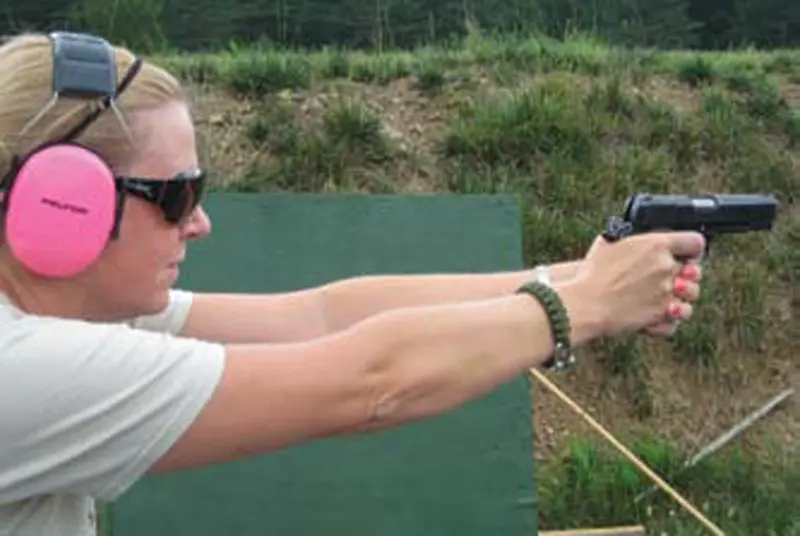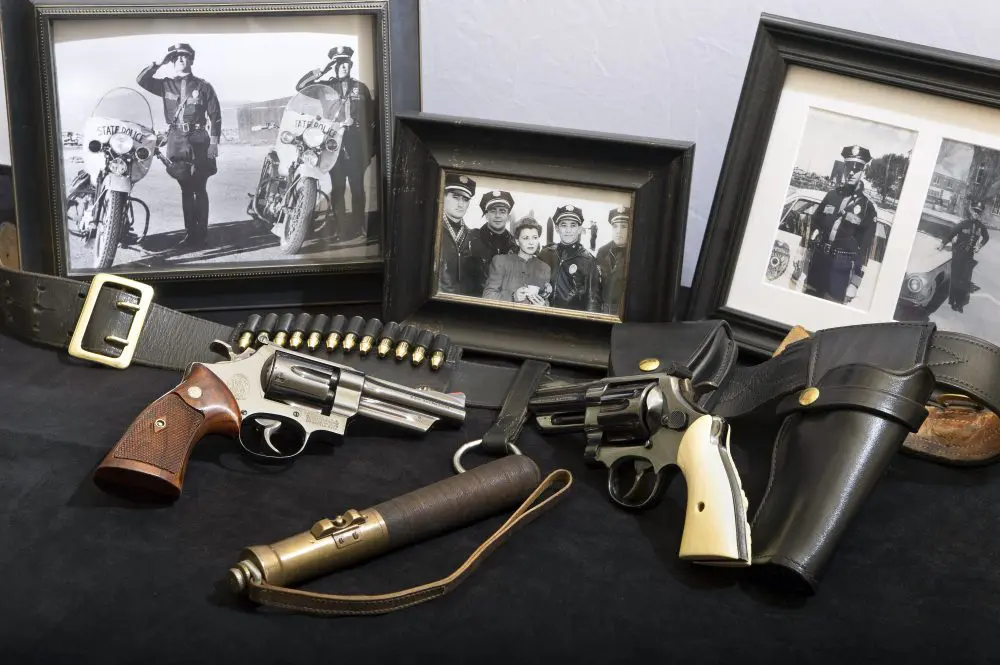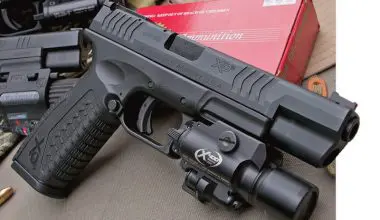

The early 20th century design is still going strong more than 100 years after its adoption by the U.S. military.
Mr. Browning would take satisfaction in the fact that military units with a choice in the matter still choose to carry his design into harm’s way over many others.
Colt was the main provider of 1911s to civilians for the first part of its existence, offering other models and calibers than just the full-size .45 ACP Government. However, Colt’s catalog was nowhere close to what today’s consumer can access in terms of 1911 models.
Many may lose sight of this with the plethora of current 1911 manufacturers now on the market, featuring 1911s in shapes and sizes that would boggle the mind of Browning himself. I do not intend to rehash all the well-known 1911 design characteristics. The 1911’s slim frame width makes it an ideal carry gun, and its single-action trigger promotes accurate shooting.

I was fortunate to acquire a vintage early 1950s Colt Commander from good friend Marc Richman. An added nuance to this Commander was that it is chambered in .38 Super. Talk about separating oneself from the pack—not only a 1911 that is older than myself, but also one chambered in a cartridge other than .45 ACP.
Table of Contents
HISTORY REVIEW
A little history pulled from various sources reveals what can be considered the first 1911 designed for ease of carry compared to pure combat effectiveness. The pistol that would eventually be named the Colt Commander was Colt Manufacturing Company’s candidate in a U.S. government post-World War II trial to find a lighter replacement for the M1911 pistol that would be issued to officers. Requirements were issued in 1949 that the pistol had to be chambered for 9mm Parabellum (that’s right, 9mm) and could not exceed seven inches in length or weigh more than 25 ounces.
Candidates included Browning Hi- Power variants by Canada’s Inglis and Belgium’s Fabrique Nationale, and Smith & Wesson’s S&W Model 39. Colt entered a modified version of their M1911 pistol that was chambered for 9mm Parabellum, had an aluminum alloy frame, short 4.25-inch barrel, and nineround magazine.
In 1951, Colt moved their service candidate into regular production for the civilian market. It was the first aluminum- framed large frame pistol in major production and the first Colt pistol to be originally chambered in 9mm Parabellum. The first year’s production also included .45 ACP and .38 Super chamberings.
In 1970, Colt introduced the all-steel “Colt Combat Commander.” To differentiate between the two models, the original aluminum-framed model was renamed the “Lightweight Commander.”
.38 SUPER
The .38 Super was derived from the .38 ACP and shares its dimensions, though loaded to higher pressures for a boost in velocity. The .38 Super was designed to fire a 130-grain bullet at the 1,300 feetper- second (fps) threshold while the .38 ACP was in the 1,100 fps range. A .38 Super fired in a .38 ACP could prove disastrous.
Colt designed the .38 Super with its Government 1911 platform in mind. Colt’s intent was a cartridge capable of penetrating the body armor and automobile sheet metal of the 1920-30s combined with the pre-eminent semiautomatic handgun designed for fighting.
It may surprise many to learn that the .38 Super cartridge has a lineage dating back to the late 1920s and was not that uncommon a 1911 chambering during the heyday of organized crime and professional criminals fostered by the Depression, along with the lawmen assigned to stop them.
COMPETITORS’ CHOICE
From its inception, the 1911 .38 Super attracted savvy aficionados to it—a characteristic that continues to this day. The .38 Super experienced resurgence in the 1970s due to its “discovery” by IPSC competitors with its ability to make Major in terms of cartridge classification because of its high velocity and mild recoil, especially when combined with a muzzle brake, not to mention its ability to fire reliably from the 1911. The .38 Super combined in a 1911-based Match gun became and still is a favorite platform for competitors.
This is for a variety of reasons, including flat shooting, tame recoil, and the extra capacity offered by the .38 Super compared to a .45 ACP 1911. The longer case length of the .38 Super (22.86mm) facilitates its feeding from magazines fitted in a 1911 frame better than the shorter 9mm cartridge (19mm). Interestingly, the .38 Super has almost the identical overall length of the .45 ACP, which explains why it works so well in the 1911 platform.
Due to similar case dimensions between the .38 Super and the .38 ACP, in 1974 SAAMI added a +P headstamp to the .38 Super to help distinguish it from the lower powered .38 ACP. The .38 Super is a regularly featured chambering in Central and South American 1911s due to gun laws limiting access to military calibers such as .45 ACP and 9mm.
Here in the U.S., the .38 Super has more of a cult following with limited sales numbers. Ammunition is still carried by multiple manufacturers, with reloading a popular option. The .38 Super’s performance benefits greatly from the increased sophistication of bullets and powders that wring the most out of its capability compared to when it first appeared in 1929.
The original .38 Super headspaced off the cartridge’s semi-rim and led to early reports of inaccuracy. More modern manufactured .38 Supers headspace off the case mouth, similar to the .45 ACP, and with accuracy on par with any pistol cartridge. Let’s face it: professional shooters would not have embraced it if it were not accurate.
The Colt Commander reviewed herein is pretty much stock including the original barrel headspacing off the cartridge rim.

TEST GUN SPECS
The Colt Commander tested features an aluminum frame with dimensions and measurements typical of a Commanderstyle 1911. It weighs in at 27 ounces empty and measures 7.75 inches long with a 4.25-inch barrel and is nearly 6 inches high. A full-length recoil guide rod that is popular on many 1911s made today is not found on the 1951 Commander, following Browning’s original design. The 1911’s width and classic svelte ergonomics make it carry and handle like no other.
The Colt Commander .38 Super features nine-round capacity magazines. I supplemented the original magazine with two acquired from Wilson Combat, my main source of aftermarket magazines for 1911s.
RANGE TIME
The evaluation of the 60-year old Colt Commander .38 Super was conducted near Winchester, Virginia at Echo Valley Training Center. Evaluations rarely consist of bench-testing pistols for accuracy because reliability and quick engagement of targets are more important in a self-defense/service handgun. A weapon like the Colt Commander chambered in .38 Super should be fired as it is designed to be used—standing without support. This is the true measure of accuracy, combining grip, sights, trigger pull and follow through.
The Colt Commander .38 Super was tested at the range first by verifying sight zero and then firing several magazines rapidly at various steel man targets. This quickly shows if any reliability issues exist. Honestly, if a pistol is not reliable, what good is it, whether it is brand new or 60 years old?
Further testing consisted of strings of fire against steel plate racks and steel popper targets at seven, 15, and 25 yards. The minimal sights did not prove a detriment to accuracy once acclimated to their use. The basic U-notch rear and small, narrow bladed front sight gave a decent sight picture as plate racks, steel poppers, and paper silhouette targets were engaged.
An informal accuracy test was conducted from a rudimentary bench position to verify if any accuracy issues existed based on reports of such due to headspacing off the .38 Super’s cartridge rim. At 15 yards, the old Commander constantly kept a full magazine worth of ammunition at 2.5 inches or better, regardless of what brand of ammunition was used.
I was more interested in the Commander .38 Super as a fighting pistol than a competition rig.
TEST AMMO
I assembled ammunition from Winchester, Federal, Wilson Combat and CorBon. For example, modern loads for the .38 Super from CorBon fire 115-grain bullets at nearly 1,450 fps. Chronographing of all loads took place to verify if the .38 Super lives up to its hype as the original .40 S&W/.357 SIG cartridge for semi-automatic handguns—it does, with the CorBon loads being the hottest. The CorBon 100-grain Pow’RBall clocked just over 1,500 fps, with the 115-grain JHP at 1,435 fps and 125-grain DPX reaching 1,320 fps.
The old Colt Commander had its recoil spring changed out in the middle of this review as advised by prominent local 1911 Master gunsmith Fred Cather. He counseled that the original half-century plus old springs needed to be updated once I described intentions of fully evaluating it via numerous rounds fired, including the CorBon and Wilson Combat loads. Fred also indicated that the old Colt Commander was stock except for someone switching out the mainspring housing with a beavertail and the grips with aftermarket parts sometime during its 60+ years of existence.
My first range session consisted of over 300 rounds after only lightly lubricating the Colt Commander. I fired an assortment of bullet configurations from the ammunition manufacturers mentioned above to verify reliability. Firing was at a relatively steady pace, with different shooters running the Commander through its paces on plate racks, dueling trees and other drills.
HIGH PERFORMANCE STANDARD
During this, all made comment on the Commander .38 Super’s surprisingly uncanny accuracy. Even with its lightweight alloy frame, the .38 Super Colt Commander was amazingly tame in the recoil department, showing why it is so favored by modern competitors and was by professionals on both sides of the law in the 1930s.
During multiple range visits, I fired over 600 rounds through the .38 Super without a hitch. Several associates stated disbelief that the Colt Commander was performing so well considering its age. I have owned and shot numerous 1911 models from different manufacturers. Some were disappointments. I admit not having much success with 1911 models utilizing short barrels and bushingless designs. The 60-year old Colt Commander had no such issues, performing in a fashion that belied its age.
ACTION DRILLS
Considering the 1911’s primary role as a fighting/defensive handgun combined with lineage of the .38 Super’s raison d’être, it was decided to further evaluate the Colt Commander using drills experienced during training at firearms schools such as Tactical Response and Storm Mountain.
The natural pointability of the Colt Commander chambered in .38 Super was confirmed, along with speed getting it into action. The beavertail frame settled the 1911 Commander naturally into my hand and provided a point of reference when drawing the pistol from a holster. Condition One “cocked and locked” carry typified by the 1911 allows a shooter to merely swipe off the safety and benefit from the lighter and shorter single-action trigger pull.
One of the unspoken benefits of choosing a 1911 for use is the plethora of aftermarket accessories available to support your decision, in the form of holsters, magazines, grips, lasers, and ammunition. My go-to holsters from DeSantis and Galco were utilized during this review.
1911 FOREVER
The 1911 is a weapon that continues to attract users with its natural handling, great trigger, and potent chamberings such as .45 ACP and .38 Super. Is the 1911 a prime weapon for all situations or users? No. However, it should be employed as a carry weapon without hesitation once it has been proven on the range.
A 1911 should be trained with to ensure that functions are natural and instinctive in case it has to be deployed in haste—the same as any other personal defense weapon. No one can argue that there is a more instinctive handling weapon than the 1911. The trigger and grip size/angle make it the most accurate handgun in most arsenals. Why do you think hostage rescue units and other special-purpose military/LE teams use it? It is accurate and conducive to precise shot placement.
The 1911 design is too well known for me to attempt any new exposé, however, the Colt Commander tested herein serves as a reminder why the 1911 still holds a prominent place in the U.S. civilian market.
The Colt Commander represents a good balance of features for daily use as a duty or concealed carry weapon. The .38 Super was designed specifically as a fighting cartridge. The .38 Super chambering in the 1950s-manufactured Colt Commander allows a user to indulge oneself by having something that’s not so typical, yet still retains functionality.




